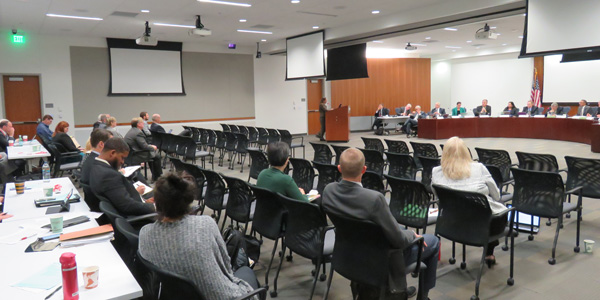By Jason Fordney
FOLSOM, Calif. — In a move that met criticism from some stakeholders, CAISO’s Board of Governors on Thursday approved two measures intended to prevent the early retirement of unprofitable — but needed — generation in California.
The board approved a reliability-must-run (RMR) contract for Calpine’s Metcalf Energy Center, saying it was an undesirable but necessary measure to maintain electric grid reliability in the Silicon Valley.
Despite the unanimous vote, the board expressed unhappiness about approving the contract, an out-of-market payment to keep the 605-MW natural gas-fired plant from retiring.
Governor Ashutosh Bhagwat said: “I am going to hold my nose very, very hard.” He added that “I understand the problem, but I think this is going to be a recurring issue and we need to come up with a solution.”
Governor Mark Ferron said he was tempted to vote against the RMR “because I am opposed to the process and the situation we find ourselves in.” But, he added, “to vote against this contract is not a risk that we should play with.”
The Metcalf RMR is the third such contract awarded to a Calpine plant this year, sparking concerns among industry participants that the CAISO market and California’s resource adequacy (RA) process are not supporting generation needed for future reliability. Calpine in June told the ISO it planned to remove the plant from dispatch on Jan. 1, 2018. The RMR contract was developed in a relatively short time frame after the ISO determined Metcalf was needed for local reliability. (See CAISO RMRs Win Board OK, Stakeholders Critical.)
Representatives from the California Public Utilities Commission, Pacific Gas and Electric and Cogentrix spoke against the agreement at the meeting.
CAISO CEO Steven Berberich told the board that use of RMR “is not at all how we want to handle procurement.” He added that “the RMR is symptomatic of a bigger problem, which is that resource adequacy is no longer able to meet the needs of the system.” He said that the ISO does not want to frequently approve RMR agreements, and that procurement should be done through the RA process.
Board Approves CPM ROR Changes
In addition to the Metcalf RMR, the board approved a separate, broader program that will pay generators to stay in service to meet reliability needs. The Capacity Procurement Mechanism Risk-of-Retirement (CPM ROR) program expands the existing CPM process to include procurement of at-risk capacity needed for the next RA compliance year.
The program includes two application windows each year — in April and November — for three types of ROR designations. As the ISO developed the process, some stakeholders — including the PUC — raised concerns that inclusion of the April window gives resources undue insight into price discovery for the commission’s RA program, which occurs in October. The commission was concerned “that moving a CPM ROR determination to a date prior to the conclusion of the year-ahead procurement process will result in front-running the RA bilateral procurement process.” (See CAISO Participants Question Retirement Program.)
CAISO added the April window based on requests from generation owners, who said they needed the option of a designation earlier in the year for planning reasons. CAISO changed the proposal to require that a resource attest that it “reasonably believes” its annual fixed costs meet or exceed certain price thresholds. Some have criticized that the ISO would accept an attestation in that regard.
CAISO Infrastructure and Regulatory Policy Manager Keith Johnson told the board that the PUC’s 2019 RA proceeding is an opportunity to address the issues that have been identified. The ISO will evaluate potential modifications to the RMR construct to better align with the current environment, he said in a presentation to the board.
No Time for Other Solutions

Keith Casey, CAISO vice president of market and infrastructure development, repeatedly took to the microphone on Thursday to rebut criticisms of both the RMR and CPM ROR. He acknowledged that the state’s RA program and ISO markets need fixes, but there is not enough time to develop them in an adequate time frame.
The ISO would normally let the RA procurement process run its course in October before signing an RMR agreement, but Calpine told it that the normal time frame would not be workable. Calpine also indicated it was not interested in the CPM ROR program, leaving the RMR as the best option, Casey said. “We don’t want to be one wire away from blacking out Silicon Valley,” he added.
“The issue for me is one of timing,” Casey said. Changing the RA construct is going to be a long and difficult process, and with increasing retirements, “we have got to have some tools to ensure that resources that are critical on the system can be retained.”
The board on Thursday also approved modifications to an incentive that is meant to ensure that RA resources can meet their must-offer obligations and provide replacement capacity if the resource has a forced outage. It changes the Resource Adequacy Availability Incentive Mechanism (RAAIM) calculation to separately calculate generic RA used for system load and flexible capacity, among other changes, according to an Oct. 25 letter from Casey to the board.
Lastly, the board voted to increase its retainer compensation to $40,000/year, which CAISO said is well below the retainers paid to the governing boards of the nation’s other RTOs/ISOs.









